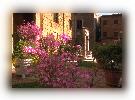Pienza - Utopian City


P
ienza,
|
|
|
a small town near Siena, is a rare example of Renaissance town building. Defined, from time to time, the "ideal city", the "utopian city", it represents one of the best planned Renaissance towns, where a model of ideal living and governing was realized thus working out the idea of a town able to satisfy the need for a pacific, civil and hardworking living. It represented the so called utopia of the "civitas" vainly cherished by people for centuries.
|

|
|
Pienza has at present two museum, a third one into being. Its location in the middle of Val d'Orcia, a wonderful and untouched valley, enables the town to perfectly embody the basic interest which the humanistic architecture gave to the relationship man - nature.
Nowadays Pienza is part of a territorial system called "Parco artistico, naturale e culturale della Val d'Orcia", which aims at preservation of the extraordinary artistic heritage of the five boroughs which constitute it: Castiglion d'Orcia, Montalcino, San Quirico d'Orcia, Radicofani and Pienza. which aims at preservation of the extraordinary artistic heritage of the five boroughs which constitute it: Castiglion d'Orcia, Montalcino, San Quirico d'Orcia, Radicofani and Pienza.
|

|
|
The center of Pienza was completely redesigned by Pope Pius II in Renaissance times. He planned to transform his birthplace into a model Renaissance town. The architect Bernardo Rossellino was
commissioned to build a Duomo, papal palace and town hall, the construction were completed in
three years.
Away from the main square, Pienza is a quiet agricultural town with shops selling local produce like 'pecorino', cheese made from sheep's milk, or the eccelent wines.
Lovers of good food will want to visit an "bottega" (grocer's) or a "forno" (baker's) to choose from the fashinating range of stock available. Tuscan products to sample and take back home include bottled antipasti, fruity olive oils and a winde variety of candy and pastry.
|

|
Il Duomo
Piazza Pio II. Open daily.
The Duomo was built by the architect Rossellino (1459) and is now suffering from serious
subsidence at its eastern end. There were cracks in the walls and floor of the nave, but the splendid
classical proportions are remained inctact. It is flooded with ligth from the vast stained glass
windows request by Pius II; he wanted a domus vitrea (litterally "a house of glass"), which would
symbolize the spirit of intellectual enlightenment of the Humanist age.
|

|
Il Palazzo Piccolomini
Piazza Pio II. Aperto Tuesday - Sunday.
The palazzo is next door to the Duomo and was home to Pius II's descendants until 1968.
Rossellino's design for the building was influenced by Leon Battista Alberti's Palazzo Rucellai in
Florence. The appartments open to the public include Pius II's bedroom and library. At the rear of
the palazzo there is an ornate arcaded courtyard and a triple-tiered loggia looking out on the garden.
From here there are spectacular views across to the wooded slopes of the Monte Amiata.
|

|
La Pieve di Corsignano
Via delle Fonti. Open by appointment. Phone to the tourist office: (+39-578-749071)
Pope Pius II was baptized in this 11 th. century Romanesque parish church on the outskirts of
Pienza. It has an unusual round tower and a doorway decorated with flower mytholgical motifs.
A crib is sculptured on the architrave of the side doorway.
|

|





